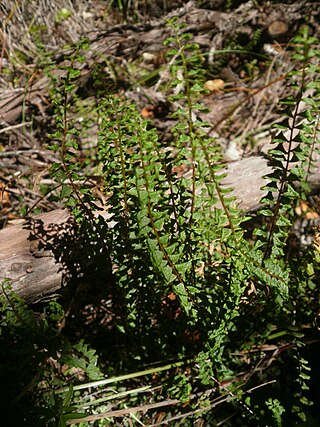
Adiantum capillus-veneris, the Southern maidenhair fern, black maidenhair fern, maidenhair fern, and venus hair fern, is a species of ferns in the genus Adiantum and the family Pteridaceae with a subcosmopolitan worldwide distribution. It is cultivated as a popular garden fern and houseplant.

Dennstaedtiaceae is one of fifteen families in the order Polypodiales, the most derived families within monilophytes (ferns). It comprises 10 genera with ca 240 known species, including one of the world's most abundant ferns, Pteridium aquilinum (bracken). Members of the order generally have large, highly divided leaves and have either small, round intramarginal sori with cup-shaped indusia or linear marginal sori with a false indusium formed from the reflexed leaf margin. The morphological diversity among members of the order has confused past taxonomy, but recent molecular studies have supported the monophyly of the order and the family. The reclassification of Dennstaedtiaceae and the rest of the monilophytes was published in 2006, so most of the available literature is not updated.

Botrypus virginianus, synonym Botrychium virginianum, sometimes called rattlesnake fern is a species of perennial fern in the adders-tongue family. It is monotypic within the genus Botrypus, meaning that it is the only species within the genus. It is called the rattlesnake fern in some parts of North America, due to its habit of growing in places where rattlesnakes are also found. Rattlesnake fern prefers to grow in rich, moist woods in dense shade and will not tolerate direct sunlight.

Dennstaedtia is a mostly tropical and subtropical genus of ferns described as a genus in 1801. Hayscented fern, or Cup ferns, are common names for some species in this genus. Its best-known member is probably the temperate North-American hay-scented fern, Dennstaedtia punctilobula, which forms extensive clonal ground-cover colonies on level surfaces in the Appalachian area.

Dennstaedtia punctilobula, the eastern hayscented fern or hay-scented fern, is a species of fern native to eastern North America, from Newfoundland west to Wisconsin and Arkansas, and south in the Appalachian Mountains to northern Alabama; it is most abundant in the east of its range, with only scattered populations in the west.

Lindsaeaceae is a pantropical family of ferns in the order Polypodiales. It contains six or seven genera with about 220 known species, some of which also extend into the more temperate regions of eastern Asia, New Zealand, and South America.
Hay-scented fern is a common name for several plants and may refer to:

Amauropelta noveboracensis, the New York fern, is a perennial species of fern found throughout the eastern United States and Canada, from Louisiana to Newfoundland, but most concentrated within Appalachia and the Atlantic Northeast. New York ferns often forms spreading colonies within the forests they inhabit.

Thelypteris palustris, the marsh fern, or eastern marsh fern, is a species of fern native to eastern North America and across Eurasia. It prefers to grow in marshy situations in full sun. The species epithet palustris is Latin for "of the marsh" and indicates its common habitat. It is the only known host plant for Fagitana littera, the marsh fern moth.

Lygodium palmatum is the only species of its genus native to North America. Unlike most species in the genus, this one, called the American climbing fern, Hartford fern, or Alice's fern, is extremely hardy in temperate zones.

Gymnocarpium robertianum, the limestone fern or scented oakfern, is a fern of the family Cystopteridaceae.

Rubus allegheniensis is a North American species of highbush blackberry in section Alleghenienses of the genus Rubus, a member of the rose family. It is the most common and widespread highbush blackberry in eastern and central North America. It is commonly known as Allegheny blackberry.

Dennstaedtia wilfordii is a species of fern in the family Dennstaedtiaceae. It was formerly placed in the monotypic genus Coptodipteris as Coptidipteris wilfordii. It is native from Pakistan through China to Korea and Japan.

Histiopteris is a genus of ferns in the family Dennstaedtiaceae described as a genus in 1875.
Hypolepis poeppigii is a fern species in the family Dennstaedtiaceae that has no common name. It is native to Chile and the Falkland Islands.

Microlepia strigosa, known as hay-scented fern, lace fern, rigid lace fern and palapalai, is a fern indigenous to the Hawaiian islands and is also native to other parts of the tropics and subtropics including India and Malaysia. This fern belongs to a group of about seventy Microlepia species in the bracken or hay-scented fern family (Dennstaedtiaceae). There are two indigenous species and a hybrid found in the main Hawaiian Islands. It is also known by the botanical names: Davallia hirta, Davallia setosa, Davallia strigosa, Dicksonia kaulfussiana, Dicksonia strigosa, Microlepia hirta, Microlepia setosa, Stenoloma tenuifolium, Trichomanes strigosum. It has coarse, light to medium green fronds which can grow to more than 3 ft (0.9 m) long.

The Platygloeales are an order of rust fungi in the class Pucciniomycetes. It contains two families, the Eocronartiaceae and also the Platygloeaceae.
Hiya is a genus of ferns belonging to the family Dennstaedtiaceae. Described in 2018, it resembles ferns of the genus Hypolepis but differs from it by multiple characteristics: scrambling, indeterminate and intermittent growth of fronds; stipule-like pinnules at the base of pinnae, and a rachis-costa architecture where the adaxial sulcus of the rachis is continuous with that of the costae and costules.















